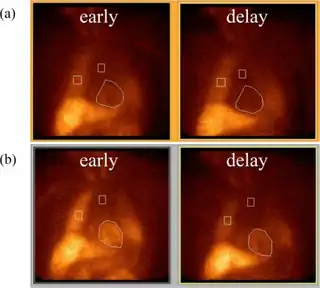Autoimmune autonomic ganglionopathy
| Autoimmune autonomic ganglionopathy | |
|---|---|
| Specialty | Neurology |
Autoimmune autonomic ganglionopathy (AAG) is a rare form of dysautonomia in which the patient’s immune system produces ganglionic anti-nicotinic acetylcholine receptor (AChR) antibodies, inhibiting ganglionic AChR currents and impairing transmission in autonomic ganglia.[1] Symptoms onset can be acute, subacute or gradual.
Signs and symptoms
Although symptoms of AAG can vary from patient to patient, symptoms are dysautonomia. Hallmarks include:
- Gastrointestinal dysmotility, including lack of appetite, nausea, constipation, diarrhea
- Anhidrosis (decreased ability to sweat), often preceded by excessive sweating
- Bladder dysfunction (neurogenic bladder)
- Small fiber peripheral neuropathy
- Severe orthostatic hypotension
- Pupillary dysfunction
- Syncope (fainting)
- Sicca syndrome (chronic dryness of the eyes and mouth) See: Xerostomia#Sicca syndrome
- No indication from the history or physical examination of cerebellar, striatal, pyramidal, and extrapyramidal dysfunction, as these features suggest the more serious multiple system atrophy.[2]
Causes
The cause is generally either paraneoplastic syndrome or idiopathic. In idiopathic AAG, the body's own immune system targets a receptor in the autonomic ganglia, which is part of a peripheral nerve fiber. If the AAG is paraneoplastic, they have a form of cancer, and their immune system has produced paraneoplastic antibodies in response to the cancer.[2]
Diagnosis
Traditional autonomic testing is used to aid in the diagnosis of AAG. These tests can include a tilt table test (TTT), thermoregulatory sweat test (TST), quantitative sudomotor autonomic reflex testing (QSART) and various blood panels. Additionally, a blood test showing high levels of the antibody ganglionic nicotenic acetylcholine receptor (gAChr) occur in about 50% of patients with AAG (seropositive AAG). The seronegative patients (those without detectable gAChR levels) are theorized to have one or more different antibodies responsible for the autonomic dysfunction. However, both seropositive and seronegative patients have been seen to respond to the same treatments. A paraneoplastic panel may also be ordered to rule out paraneoplastic syndrome.[3]
Treatment

Where an underlying neoplasm is the cause, treatment of this condition is indicated in order to reduce progression of symptoms. For cases without a known cause, treatment involves suppression of the immune system with corticosteroid treatment, intravenous immunoglobulin, immunosuppressive agents like rituximab, myophenolate mofetil (Cellcept), or azathioprine (Imuran) or plasmapheresis.[4]
See also
References
- ↑ Steven Vernino, MD; Steve Hopkins & Zhengbei Wang, MD (2009). "Autonomic ganglia, acetylcholine receptor antibodies, and autoimmune ganglionopathy". Autonomic Neuroscience. 146 (1–2): 3–7. doi:10.1016/j.autneu.2008.09.005. PMC 2677210. PMID 18951069.
- 1 2 Paola Sandroni & Phillip A. Low (2009). "Other Autonomic Neuropathies Associated with Ganglionic Antibody". Autonomic Neuroscience. 146 (1–2): 13–17. doi:10.1016/j.autneu.2008.10.022. PMC 2671239. PMID 19058765.
- ↑ Vernino, Steven; Low, Phillip A. (2012). "Autoimmune Autonomic Ganglionopathy". Primer on the Autonomic Nervous System. pp. 489–492. CiteSeerX 10.1.1.657.2841. doi:10.1016/B978-0-12-386525-0.00100-1. ISBN 9780123865250. Archived from the original on 2020-08-13. Retrieved 2020-10-13.
- ↑ Christopher H. Gibbons, MD, MMSc; Steven A. Vernino, MD & Roy Freeman, MD (2007). "Combined Immunomodulatory Therapy in Autoimmune Autonomic Ganglionopathy". Arch. Neurol. 65 (2): 213–217. doi:10.1001/archneurol.2007.60. PMID 18268189.
{{cite journal}}: CS1 maint: multiple names: authors list (link)
External links
| Classification |
|---|